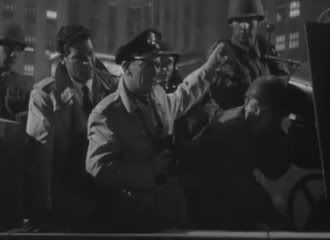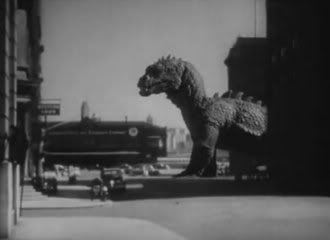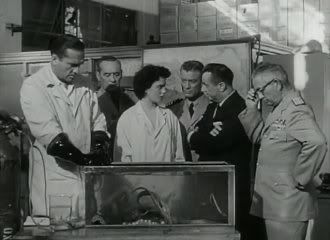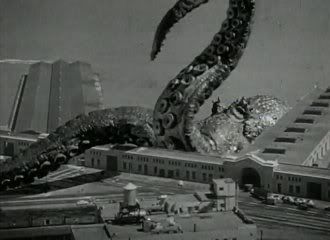What the cumulative effects of all these atomic explosions and tests will be, only time can tell.


The theme for June's Kryptic Army Mission is "Stay Out of the Water!" -- the perfect excuse to dredge up a couple of Ray Harryhausen's early monster movies. (Amazing to think he's still with us and will be celebrating his 91st birthday on Wednesday.) Up first is 1953's The Beast from 20,000 Fathoms, which is about a dinosaur that is released from the arctic ice in which it's been hibernating for a hundred million years by an atomic explosion and makes its way to Lower Manhattan (where its attack is called "the worst disaster in New York's history"). Before it gets there, though, it takes out a couple boats and a lighthouse (the subject of the Ray Bradbury story that is credited with "suggesting" the film). And at one point we're also treated to a battle between a shark and octopus which, being regular-sized, are easily devoured by the title creature. Perhaps if they had been a mega shark and a giant octopus the odds would have been a little more even.
First-time director Eugène Lourié keeps the action moving along at an admirable clip (it helps that the monster is never kept off-screen for too long). And the human element -- atomic scientist Paul Christian, paleontologists Paula Raymond and Cecil Kellaway, and Army colonel Kenneth Tobey -- doesn't get in the way as it occasionally can in these films. Interestingly enough, just as it got us into this mess, radioactivity also saves us -- with an assist from expert marksman Lee Van Cleef (in one of his earliest screen roles) during the exciting amusement park finale. Harryhausen would get to work with bigger budgets down the line, but here his technical expertise and ability to orchestrate destruction on a large scale are already very much in evidence.


In many ways, 1955's It Came from Beneath the Sea was a bit of a step back for Harryhausen since he was given a less interesting monster to animate (a giant radioactive octopus released by H-bomb tests in the Pacific) and, more to the point, less money to work with. (This is why the creature only has six arms instead of the standard eight.) The film is also saddled with a boring-ass romantic subplot and director Robert Gordon commits the cardinal sin of waiting until the 28-minute mark to give us our first glimpses of It. (Considering how tight the purse strings were, though, he might not have had much choice there.)
On the acting front, Kenneth Tobey is back in uniform as the captain of an atomic submarine that is set upon by something (which is economically kept off-screen) during its maiden voyage, with Faith Domergue as the marine biologist he has the hots for and Donald Curtis as the marine biologist she may have the hots for. Or maybe she just likes to play the field. Or, you know, whatever. Frankly, I found their sub-screwball "battle of the sexes" banter so inane that I quickly tuned it out and waited patiently for the plot to kick back in -- and I can easily imagine matinee audiences in 1955 getting just as restless. Unfortunately, the monster's assault on San Francisco is something of a letdown because hey, it's an octopus. It's just not that mobile. If Harryhausen had had the resources to animate it coming out of the bay and laying waste to the city that would be one thing. As it stands, this is the definition of anti-climactic.